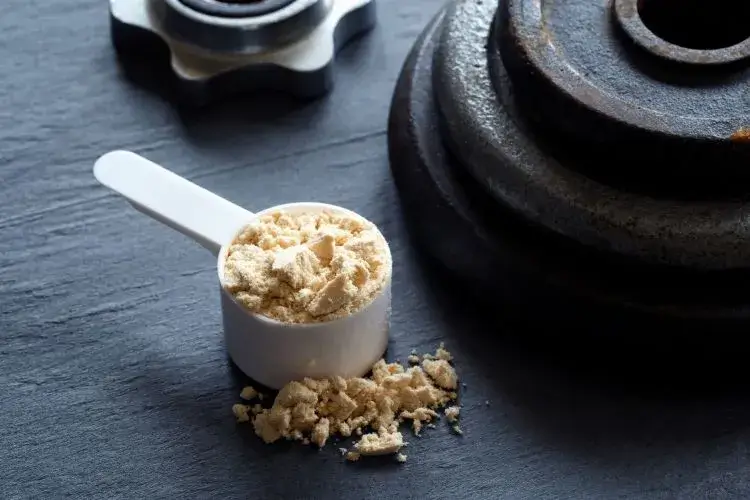

Are you seeking to decode muscle growth mechanisms for peak body conditioning?
Look no further. Let’s dive deep into the science, uncovering secrets to propel you to fitness potential.
Muscle growth is vital for health, metabolism, and strength.
Grasping the science equips you to make informed choices, optimising training and nutrition for maximum effect.
Understanding this dance unlocks sustainable muscle growth. Refine workouts, nutrition, and recovery, stimulating growth and enhancing development.
Join us on this enlightening journey to transform your approach to optimal physical development.
Muscle fibres are the essential units of muscles, crucial to muscle growth. There are different types of muscle fibres, each with unique characteristics and roles in physical activity and muscle development.
Also known as slow-twitch fibres, these are fatigue-resistant and predominantly support endurance activities such as long-distance running or cycling. Their resilience to fatigue makes them indispensable for sustained, low-intensity workouts.
These split into Type IIa and Type IIb fibres. Type IIa fibres, while moderately enduring, generate more force than Type I fibres, making them ideal for medium-intensity activities requiring a mix of strength and endurance. On the other hand, Type IIb fibres can produce even more force but fatigue quickly. These fibres are pivotal for power and speed exercises, like sprinting or heavy weight lifting.
Your muscle fibre composition can significantly influence your training and muscle growth. For instance, if you have a higher proportion of Type II fibres, you might naturally excel in strength and power exercises. Understanding your muscle fibre type can guide the development of a workout routine tailored to your body’s specific needs and capabilities to optimise muscle growth.
Muscle hypertrophy is the technical term for the increase in muscle size, a crucial factor for those aiming to enhance physical strength or aesthetic appeal. There are several key factors promoting muscle hypertrophy:Mechanical tension: Engaging in physical activities such as weightlifting or resistance training puts tension on the muscles. This tension acts as a stimulus, prompting them to adapt and grow in response to the exerted force.Metabolic stress: When you indulge in intense exercise, metabolites, like lactate, start to accumulate in the muscle tissue. This metabolic stress serves as a biochemical signal for the body to initiate processes of muscle growth and repair.Muscular damage: High-intensity workouts can induce micro-tears in muscle fibres. Although it may sound detrimental, this damage is actually beneficial in the long run. The body sets in motion a repair process in response to these micro-tears, and the repaired fibres grow back stronger and larger, contributing to muscle hypertrophy.
Understanding these mechanisms of muscle hypertrophy is pivotal to designing effective workout routines and recovery strategies for optimal muscle growth.
Central to muscle growth and repair is the process of protein synthesis. Protein synthesis is the biological mechanism through which new proteins are created. After an intense workout, the body responds to muscular damage by initiating protein synthesis to repair the damaged fibres, fortifying them to become stronger and larger.
When it comes to fueling protein synthesis and, in turn, muscle growth, your dietary intake is paramount. Consuming an optimal amount of protein daily is essential for reinforcing the protein synthesis process, and subsequently, promoting muscle growth. The recommended protein intake varies based on factors such as activity levels and body weight. For instance, those who engage in high-intensity workouts or strength training may need to consume more protein than those who are less active. It’s important to tailor your protein intake to your activity level to ensure that your muscles have all the necessary resources for growth and repair.
It’s important to note that protein consumption should be timed appropriately for maximum benefit. Consuming protein shortly after a workout can optimise muscle repair and growth by making the necessary amino acids for protein synthesis readily available.
By understanding the significant role of protein synthesis in muscle growth and the importance of optimal and appropriately timed protein consumption, you can better equip your body to build and repair muscle, enhancing your overall physical development.
Resistance training forms a crucial component of the muscle growth process. This type of exercise applies resistance against muscle contraction, creating micro-tears in the muscle fibres. While this may sound harmful, it’s a natural part of muscle growth and development. Upon initiating a repair process in response to these micro-tears, the body fortifies the muscle fibres, allowing them to grow back stronger.
Techniques such as progressive overload play an instrumental role in resistance training. Progressive overload involves gradually increasing the resistance or workout intensity over time. This continual challenge to the muscles prompts them to adapt, leading to increased strength and muscle size. Whether you’re adjusting the weight, increasing the number of repetitions, or altering the exercise itself, progressive overload is a tried and trusted way to maximise muscle growth.
Understanding and effectively applying these techniques in resistance training can significantly accelerate your journey towards achieving your muscle growth goals.
Hormones play a crucial role in the process of muscle growth, with testosterone and growth hormones being particularly influential. Testosterone, the primary male sex hormone, plays a substantial role in promoting muscle mass and strength. It stimulates protein synthesis, fosters the growth of muscle tissues, and aids in the recovery process post-workout. Growth hormone, on the other hand, contributes to muscle growth by stimulating the release of insulin-like growth factor (IGF-1), a hormone that promotes muscle protein synthesis and growth.
Balancing these hormones involves:Getting adequate sleep: Sleep is an essential factor for hormone regulation. During deep sleep, the body releases growth hormone, which is crucial for muscle recovery and growth. Therefore, ensuring you get a good night’s sleep is fundamental for optimal muscle development.Reducing stress: High stress levels can elevate cortisol, a hormone which can inhibit muscle growth. Cortisol can induce muscle protein breakdown and inhibit growth hormone production. Therefore, keeping stress levels in check is paramount for maintaining a healthy hormonal balance conducive to muscle growth. Various stress-management strategies, such as meditation, deep breathing exercises, and yoga, can help in this regard.
Through understanding the significant impact of these hormonal factors on muscle growth, individuals can take essential steps to ensure their hormonal health is aligned with their muscle growth objectives.
Anabolic steroids can dramatically boost muscle growth and performance, making them alluring to some athletes and fitness enthusiasts. These substances mimic the function of testosterone in the body, promoting an increased rate of protein synthesis and muscle cell growth. However, the use of anabolic steroids comes with significant health risks.
Prolonged use can lead to adverse side effects such as liver damage, cardiovascular diseases, mood disorders and hormonal imbalances, among others. Moreover, anabolic steroids can also result in dependency, further exacerbating health risks. Ethically, their use is often regarded as cheating in sports, leading to severe penalties, including disqualification and reputation damage.
It’s crucial to note that muscle growth and performance improvements can be achieved through natural means such as proper diet, resistance training, and adequate rest. Understanding the risks associated with anabolic steroids can help individuals make informed decisions about their health and fitness goals.
Proper nutrition serves as the foundation for muscle growth, encompassing several key components:Protein: Essential for muscle repair and growth, protein provides the building blocks for new muscle tissue. Consuming an optimal amount of protein each day reinforces the protein synthesis process, which in turn promotes muscle growth.Carbohydrates: Carbohydrates play a significant role in fueling workouts and replenishing glycogen stores in muscles, which is paramount for recovery and growth. Including a variety of complex carbohydrates in your diet can provide sustained energy and facilitate optimal performance and growth.Healthy fats: Healthy fats are integral to many bodily functions, including hormone production and cell function. Hormones like testosterone, which significantly influence muscle growth, rely on dietary fats for their production.
Balancing these macronutrients and ensuring that there’s a sufficient caloric intake to support muscle growth is crucial. Nutrient timing also plays a pivotal role in muscle development. Consuming protein near workout sessions can optimise muscle repair and growth by readily availing the necessary amino acids for protein synthesis. Understanding the crucial role of nutrition in muscle growth can significantly enhance your muscle-building journey.
Just as critical as training for muscle growth are rest and recovery. They provide the body with a necessary opportunity to repair and strengthen itself between workouts. Here are a few strategies to ensure optimal recovery and rest:Engage in light aerobic activity post-workout: Light activities such as walking or cycling at a slow pace can increase blood flow to muscles, promoting faster recovery and reducing muscle stiffness.Ensure adequate sleep: Sleep is paramount for muscle repair and overall health. During sleep, the body repairs muscle tissues and replenishes energy stores. It is during deep sleep when growth hormones are released, aiding in muscle recovery and growth. Therefore, ensuring a good night’s sleep is fundamental for muscle growth.
By incorporating these strategies into your routine, you can optimize your body’s recovery process, paving the way for effective muscle growth.
As we age, muscle growth naturally slows down and muscle atrophy, or the loss of muscle tissue, becomes a concern. This happens due to a variety of factors, including hormonal changes, decreased physical activity, and changes in the nervous system. However, these age-related changes don’t have to be a sentence to weakness or frailty. Resistance training and maintaining an active lifestyle can significantly counteract the muscle loss that comes with age. Regular resistance training stimulates muscle protein synthesis, helping to maintain muscle mass and strength. Likewise, an active lifestyle keeps the muscles engaged and helps to slow down the rate of muscle loss.
Proper nutrition also plays a crucial role in muscle maintenance, regardless of age. Consuming a balanced diet rich in protein provides the essential amino acids that our bodies need to repair and build new muscle tissues. Including a variety of nutrients in your diet ensures the body has the necessary elements for muscle health and overall well-being.
In conclusion, ageing and muscle atrophy may be a natural part of life, but they can be effectively managed. Through a combination of regular resistance training, an active lifestyle, and proper nutrition, it’s entirely possible to maintain muscle mass and strength, promoting a healthy and active life at any age.
We’ve explored the multifaceted science of muscle growth, covering muscle fibres, hypertrophy, protein synthesis, resistance training, hormonal influences, nutrition, recovery, and the impact of ageing.
By applying these scientific principles, you can make informed decisions in your training and nutrition, leading to enhanced muscle growth and performance. This comprehensive guide equips you with the knowledge to apply these insights for improved muscular development and training outcomes.